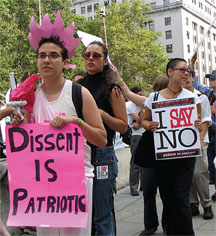|
Freedom of Speech and Expression
There have probably been more free speech cases decided by the Supreme Court than any other kind of case. Some of the highlights of the Court’s rulings include the following:
2. It must be content neutral, that is, it cannot single out a single set of ideas or concepts to be limited. For example, a law prohibiting the placement of flyers on telephone poles is permissible under the Constitution. However, if only religious flyers were prohibited while flyers with other kinds of content were allowed, the law would not be constitutional. 3. Laws must be specific. If they are too vague, the Court has also expressed concern that they might cause a chilling effect on expression. When the Congress recently passed a law against obscene and indecent expression on the Internet, the Court ruled that the law was too vague and declared it unconstitutional because it was causing people to censor themselves out of fear that they might unknowingly violate the law. 4. Such laws must also be the least drastic means available for accomplishing its stated objectives. For example, there is a clear public interest in keeping streets safe and, to the degree possible, free from congestion. Toward this end, a city might decide to ban all parades or marches on its streets. Such a ban, however, would not be the least restrictive means available. Instead, limiting the time and duration of parades and marches and requiring prior public notice of them would achieve the stated goals of the more restrictive law without unduly infringing on the individual freedom of expression. While the Supreme Court has been consistently protective of free speech and expression, the Court has upheld limitations on speech and expression in several instances. In general, these limits fall into three categories: content restrictions, place restrictions, and symbolic speech. In allowing these restrictions, the Court has affirmed that the rights of individuals are not absolute or without reasonable limitations. Some examples of kinds of speech or expression which are not protected by the First Amendment include:
Additionally, the Court has ruled that expression can be limited in places where peace, quiet and orderliness are required, such as court rooms, schools, and jails.
 
This work is licensed under a Creative Commons Attribution-Noncommercial-Share Alike 3.0 Unported License |
About Us | Terms of Use | Contact Us | Partner with Us | Press Release | Sitemap | Disclaimer | Privacy Policy
©1999-2011 OpenLearningWorld . com - All Rights Reserved


